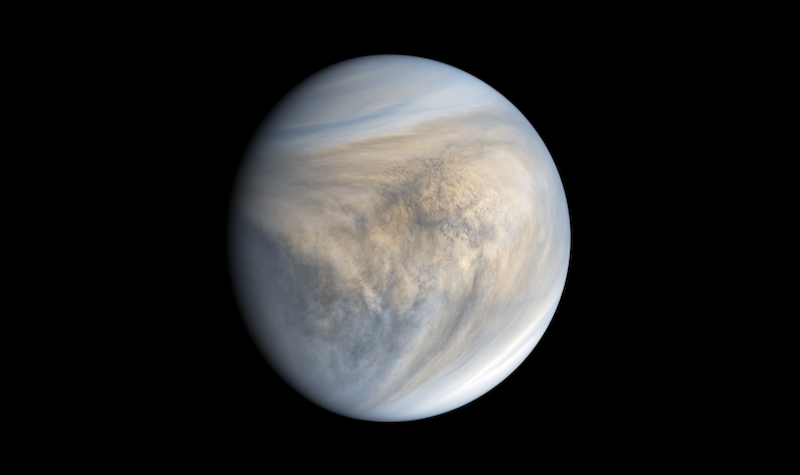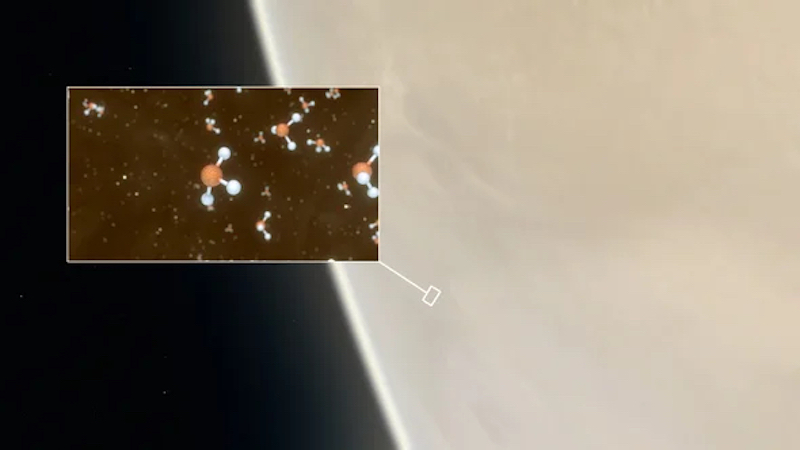
Life on Venus?
We are of the opinion that several anomalies in the atmosphere of Venus provide evidence of yet-unknown processes and systems … The investigation of these anomalies on Venus should be open to [a] wide range of explanations, including unknown biological activity.
So begins a new paper from researchers in the U.S. and U.K. – released November 14, 2022 – related to the continuing saga of possible life in the clouds of Venus. The paper looks at how phosphine is just one of various peculiar features in Venus’ clouds that airborne microorganisms – tiny living creatures such as alien bacteria or fungi – might explain.
The researchers also consider the anomalies in context of previous assumptions about Venus’ atmosphere and past discoveries in astronomy, biology and geology.
The new paper, by Carol Cleland (University of Colorado, Boulder) and Paul Rimmer (University of Cambridge), is available on arXiv. The Aerospace (MDPI) Special Issue “The Search for Signs of Life on Venus: Science Objectives and Mission Designs,” has accepted it for publication. The researchers explain:
We provide an overview of two anomalies, the tentative detection of ammonia and phosphine in Venus’s atmosphere. These anomalies fly in the face of the tacit assumption that the atmosphere of Venus must be in chemical redox equilibrium, an assumption connected to the belief that Venus is lifeless.
The discovery of phosphine
Jane Greaves and her colleagues at Cardiff University in the U.K. first announced the discovery of phosphine in the atmosphere of Venus in September 2020. The announcement ignited both excitement and skepticism among scientists.
And the debate of phosphine’s origins – or if it’s even actually there at all – is still ongoing. After all, on Earth, phosphine in the air is associated with life processes. So scientists, who are understandably fascinated by the possibility of life processes on Venus, have published several additional papers since the original discovery.
The subsequent papers are both pro and con on the subject of whether phosphine exists in Venus’ clouds, and, if so, whether it indicates life.
More anomalies
While phosphine is the most recent anomalous discovery in Venus’ atmosphere, there’s also other weird chemistry going on there, chemistry that could even point to life signs, or, as scientists say, potential biosignatures. This includes the presence of ammonia, and the fact that Venus’ atmosphere is seemingly somehow in what scientists call redox (chemical) disequilibrium.
On Earth, biological life causes chemical disequilibrium in our atmosphere. The current paper focuses on the ammonia (NH3), phosphine and redox disequilibrium (redox indicates a specific kind of chemical disequilibrium).
Scientists say that finding chemical disequilibrium in the atmosphere of a rocky exoplanet would be one of the best possible signs of life on that planet. But what about Venus? Cleland and Rimmer note that:
Few astrobiologists anticipated finding such evidence on Earth’s next-door neighbor, Venus.
The paper notes other strange features as well:
Anomalous phenomena observed in the atmosphere of Venus include the depletion of sulfur and water in the clouds of Venus, the strange behavior of SO2 [sulphur] near the surface and H2O in the clouds, the detection of O2 [oxygen], H2S [hydrogen sulphide] and CH4 [methane] in the clouds and non-detection of O2 [oxygen] above the clouds … the depletion of OCS [carbonyl sulphide] below the clouds, the detection of phosphorous clouds below sulfur clouds and a host of phenomena in the surface mineralogy: the mineral composition does not appear to be in equilibrium with the lower atmosphere.
The researchers present their case that at least some of these anomalies might be explained by biological processes.
The strange case of ammonia
The presence of ammonia is one of the most interesting Venusian anomalies. According to the current standard understanding of Venus’ atmosphere, it shouldn’t be there.
The Soviet Venera 8 probe found evidence of ammonia in 1972. The data suggested its presence at concentrations of 100-1000 ppm (parts per million), at an altitude of between 19 and 28 miles (30 and 45 km). Some other scientists dismissed the findings, however. They said that the data were “inconsistent with the observed abundances of other gases in the Venus atmosphere.” Ammonia shouldn’t be in Venus’ atmosphere. Otherwise, it would mean that the planet’s atmosphere must be in disequilibrium.
That’s a big deal, since on Earth, at least, the presence of life is what causes a similar atmospheric disequilibrium.
Later, in 1978, the Pioneer Venus multiprobe also found signs of ammonia. However, in light of the previous dismissal, these findings were either ignored or just not noticed, the researchers behind the current paper say. So, if the ammonia is there, then is the disequilibrium caused by microorganisms or unknown abiotic (non-life) chemical reactions?
The phosphine debate now
The Venusian phosphine is still a subject of much debate. Greaves and her colleagues made the initial observations using the Atacama Large Millimeter/sub-millimeter Array (ALMA) and the James Clerk Maxwell Telescope (JCMT). In a new paper, announced on November 21, 2022, Greaves and her team maintain that the phosphine is really there. The paper, available on arXiv, discusses an analysis of Venus’ atmosphere with data from the Stratospheric Observatory For Infrared Astronomy (SOFIA) telescope. Based on their discussion on six phosphine results, they say:
We suggest Venusian phosphine is indeed present, and so merits further work on models of its origins.
Recent re-analysis of data from the old Pioneer Venus mission also supports the existence of the phosphine.
Phosphine above Venus’ clouds?
Other scientists say that if the phosphine is there, it must be above the clouds, not in them. But if so, it would be even more unstable, and need to be constantly replenished somehow. Known chemical processes, both biological and non-biological, would have a hard time explaining phosphine above the clouds. And indeed, Cleland and Rimmer say:
If there is observable [phosphine] above the clouds of Venus, we are left with two explanations: life-as-we-don’t-know-it and nonlife-as-we-don’t-know-it. Both of these possibilities should be seriously considered, and neither should be clearly favored over the other until there’s more data. Instead, more predictions should be made, and more data should be gathered, especially in situ data from upcoming missions.
Scientists have proposed some possible non-biological explanations for the phosphine, such as volcanoes. But so far, none of them adequately explain all the observations.

Anomalies in scientific discovery
The researchers argue that anomalies – phenomena that are surprising or unexpected – should be acknowledged, not ignored. They are also not just “failed predictions” as often described, but play central roles in the process of scientific discovery. As the paper says:
While a failed prediction may eventually be recognized as anomalous, many anomalies do not represent failed predictions. Anomalies are surprising because they fall outside the scope of expectations (articulated in prediction and explanation) induced by widely accepted theoretical frameworks.
So, with Venus as a test case, what is the best way forward for researchers? Cleland said:
We can best explore astrobiologically by roaming widely and keeping a sharp eye out for anomalous order of any kind … Such anomalous order will indicate either an interesting nonbiological process that we need to learn about† or that we have at last found new life.
Biological anomalies on Venus: What if?
If any of these anomalies really are the result of life, it would have a profound effect on our understanding of how life evolves on planets. If life can exist on a hellish a world as Venus, where else might it be? Confirmation of such life would open up a universe of possibilities. But even if these anomalies are non-biological in origin, that would still expand our scientific knowledge overall.
Bottom line: Is there life in Venus’ atmosphere? Researchers in the U.S. and U.K. make the case for ammonia, phosphine and other potential biological anomalies on Venus.
Source: Ammonia and Phosphine in the Clouds of Venus as Potentially Biological Anomalies
Source: Recovery of Phosphine in Venus’ Atmosphere from SOFIA Observations











